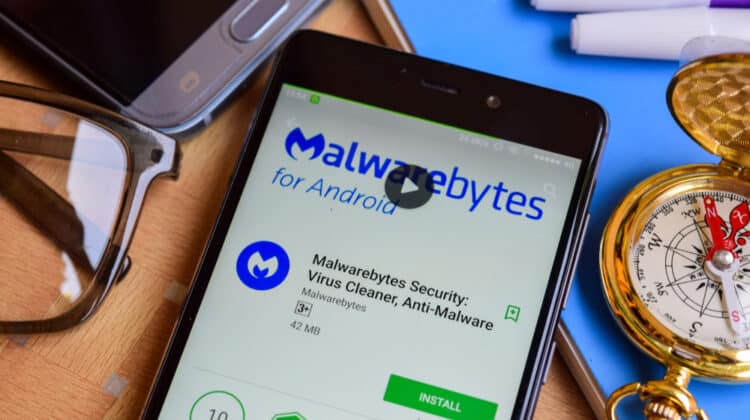
Have you been getting weird emails recently and are now worried about getting infected with malware?
We always hear about practicing cyber hygiene to protect our computers, accounts, and personal data.
Getting emails from unsolicited sources can be scary, especially since hackers and criminals use highly sophisticated methods.
So, you may wonder if your system can get infected through a malicious email.
Can Your Computer Become Infected With A Virus Via Email?

Yes, viruses can infect your computer via email—it’s a classic way of attacking personal and corporate computers.
If you receive an email that contains a virus, your computer can’t get infected until you click on something.
Simply opening an infectious email doesn’t spread the virus to your computer.
The only way to infect your computer is by clicking on a link or attachment inside the email.
However, that hasn’t always been the case, and you may even know someone who infected their computer by simply opening an email.
The main reason for this was a security hole in email programming languages.
In the past, emails accepted both HTML and JavaScript, a programming language that can add images to the text.
Hackers could send viruses through JavaScript images.
However, today’s emails only accept HTML—the same language used to create web pages.
As a result, an email is essentially a web page.
Hackers must now use other methods to send you viruses and infect your systems.
Ways An Email Virus Is Delivered To You

Since it’s become more difficult to attack people via email, hackers use other attractive ways to lure you.
Below are the most common ways they target average users.
1. Harmful Attachments
Most infected emails appear to be from a legitimate sender.
Attackers will go to great efforts to develop phishing messages that seem like legitimate emails from a trusted source.
They use the same language, fonts, logos, and signatures to make you feel the emails are genuine.
However, they include attachments such as ZIP files, PDFs, Word documents, photos, or videos containing the virus.
When the unsuspecting target clicks these attachments, they get infected.
2. Domain Changing
This method is more subtle and requires more attention to detail.
You may get an email from an unsolicited source, but everything seems normal and it contains an innocent-looking link belonging to a legitimate source.
What you don’t notice is that hackers usually make tiny modifications to domain names or IP addresses to mislead the victim.
For example, they may send you an email with a website URL that seems to belong to a university you’re familiar with.
They may make subtle changes to the spelling of the university name or use the exact name but with a different domain extension.
3. Virus Hoax
“You need to make as many people aware as possible; a new virus has spread across the world, and it’s going to turn us all into zombies; tell everyone to be careful!”
You’ve likely received messages like this, which falsely warn you of fake news and urge you to share the message with all of your contacts.
Another example is when a hacker contacts a victim over the phone and offers to fix an issue they claim to have identified on their computer.
They’ll want you to download and run an application that lets them access your computer so that they can solve the problem.
Can You Get A Virus By Replying To An Email?

Opening and replying to an email without revealing personal information is harmless.
Years ago, opening and responding to an unsafe email might have been risky, but now you can reply to an email without fear of getting a virus on your computer.
However, identifying phishing emails isn’t that simple.
Hackers are becoming more skillful and creative in persuading you they’re legitimate.
Some of their messages might be funny like, “Your unknown uncle left you 20 million dollars, so send us your credit card information so we can send you the money.”
However, don’t expect bad guys to send clear messages.
These hackers might pretend to be a person or group needing your help to trick you into giving them access to your data.
Hackers with professional experience could send an email to you from a well-known app or website that you frequently use.
After that, they’ll urge you to do things as quickly as possible to make things seem intense.
In these cases, they try to get your password or phone number for the following purposes.
1. They Want Your Hard-Earned Money
You’ve probably received an email from an unknown source requesting sensitive information.
The email seems pretty convincing, and you’re interested in responding to see what will happen next.
For example, you may get an email that appears to be from your bank.
It has a link that takes you to a gateway to pay your fees.
While it looks like the payment gateway you always use, it can be a phishing page that steals your bank account information.
Ignore these emails so you won’t have to worry about losing the money you’ve worked so hard to make.
If they hack your email and subsequently, your computer, they have access to your personal information and may blackmail you.
2. They May Hack Your Account
Cyber hackers may access your account if you respond to an infected email with identifiable information.
At the bottom of your emails, you may include a personal signature, the name of the firm you work for, or even your full name.
With this knowledge, a hacker may have an easier time figuring out your password.
3. They Will Know Your Account Is Active
Replying to spam isn’t always harmful; still, it may have annoying consequences.
By replying, you’re confirming that you have an active account.
And consequently, you will notice a rise in the spam emails you receive.
Nobody enjoys being bombarded with a large number of spam messages daily.
How To Ensure Email Attachments Are Safe

Now that you know email attachments can be dangerous, it’s easy to get paranoid and ignore every email containing attachments.
But you can’t dismiss everything you get as potentially harmful; otherwise, you may miss out on opportunities presented in legitimate attachments.
Here are some ways that you can screen your emails.
1. Don’t Open Spam Email Attachments
Email services, including Gmail, Outlook, and Yahoo Mail automatically check incoming email attachments for malware.
These email clients either delete or transfer the email from the inbox to the spam box.
As a result, never open an attachment from a spam email.
If an email has been transferred to the spam folder accidentally and you miss it, the sender will likely get in touch with you another way.
2. Check The Link
If you want to check where the link goes, hover the mouse pointer over the link without actually clicking on it.
You can see the full address in the bottom left corner of the page.
You can also right-click and copy the URL, then paste it into Word or Notepad to get the complete address.
Trust your gut if you think the URL looks weird.
3. Be Careful About File Extensions
GIF, TIF, and MPG are a few examples of file extensions.
You can find the file extension after the dot in the link addresses.
You might be familiar with files that have the .exe extension, which is primarily used for running a program and is not inherently dangerous.
However, why would a stranger email you a program to download?
Delete the email immediately if it contains an executable file.
Furthermore, be careful with files that have more than one extension and consider all of them a potential threat.
Remove any files that have more than two extensions.
4. Make Sure The Email Address Is Not Fake
Hackers can fake an email address.
They may send you an email pretending to be from a well-known corporation, such as Amazon or your office.
Why would Amazon send you attachments, particularly when you haven’t asked for them?
Trust your gut and ensure the email address is genuine.
5. Read The Email Subject
“Congratulations, you have won a million-dollar prize!”
Did you get an email with this subject line?
Did you even participate in a lottery or game in which you could win a prize?
Keep an eye out for claims that seem too good to be true.
An email containing viruses will often catch your attention before you even open it.
6. Delete The Emails That Ask You To Enter Your Password
“Your account has been restricted.”
“To solve this issue, enter your username and password!”
If you get an email that requires you to enter a password, delete it no matter what.
For peace of mind, it’s a good idea to visit the website or app that the email claims to be from and verify your account there.
More Ways To Vet An Attachment

- Other noticeable signs include misspellings and grammatical mistakes that you should notice. Will Amazon or any other multinational corporation make grammatical mistakes?!
- Avoid opening emails that include just an attachment and no other content. You don’t want to open an attachment when there’s no information other than a file attached to an email.
- For suspicious attachments in emails from someone you know, call the sender and verify whether they sent the email.
- Avoid emails that promise you money or a reward like, “Click the link below to become a millionaire.”
Types Of Email Viruses

When you get a virus on your computer via email, it can affect you in different ways.
Here are the most common ways.
1. Ransomware
As soon as the hackers access your computer, they encrypt all your data, making it impossible for you to access it.
They may also warn you not to make their hack public.
They will contact you and demand money.
In many instances, the person demanding ransom will provide a time limit for payment.
If the victim doesn’t pay the ransom in time, the hacker will either delete the data or ask for more money.
In most ransomware attacks, the hacker will demand that you pay the requested money in virtual currency, such as Bitcoin, so that no one can identify them.
2. Business Email Compromise Or Whaling
The top executives of firms are the primary targets of whaling.
These scams ask the employee to send money by creating a feeling of urgency using information specific to the individual or business.
Whaling phishing attacks also use formal tone and language so they seem more legitimate and business-like.
3. Social Engineering
Social engineering is a tactic attackers use to persuade individuals or employees to disclose confidential information.
In most cases, they use manipulation to get the victim to act quickly.
How To Avoid Email Viruses

We live in a world full of technology, and while we wish to avoid getting infections, we have no intention of stopping using email.
It’s possible, however, to use email daily but still prevent your computer from getting viruses.
Follow the guidelines below to ensure the security of your email account.
1. Keep Your Browser Or Application Updated
A simple way to avoid viruses is to frequently check for and install software updates.
Tech companies are constantly releasing software upgrades to improve the safety of their products because hackers consistently discover security flaws and exploit them.
Updates cover these security gaps and protect your computer.
2. Install An Antivirus
You might face trouble if you’re not careful while using the Internet.
Installing anti-virus software and keeping it up to date is one of the most effective preventative measures you can take against viruses.
Anti-virus tools check incoming emails and prevent viruses from entering or affecting your system.
3. Ask For Help
Have doubts about an email’s authenticity but cannot determine if it contains a virus or not?
Feel free to ask your friends or any technicians you know for help.
You may also ask other people whether they have ever dealt with infected emails, share your information with them, or get help from them to protect your system from viruses.
Search the Internet to learn more about infected emails and other people’s experiences with them.
4. Don’t Share Your Email Account
You’ve likely used the same email address to sign up for several websites.
It’s better to avoid signing up for websites whose legitimacy you’re not sure of.
Even if you want to make your email address public on the Internet, it’s worth remembering that you should never use the password for your email account on other websites.
5. Install A Spam Filter
All email clients provide a spam filter for their users.
However, there’s a possibility that they might not always be sufficient.
When you install another spam filter, each email must pass through not one but two filters before getting into the inbox.
This means that even if the email gets through one spam filter, the second one should catch it.
6. Change Your Email Address
Do you consistently get a ton of spam emails?
Hackers may have your username on their list because of a data breach that contained your information.
Spam may be difficult to stop when hackers discover that your account is active.
Changing your email address is one of your options in this situation.
NEXT: 20 Best Books On Computer Networking (2023 Updated)

























